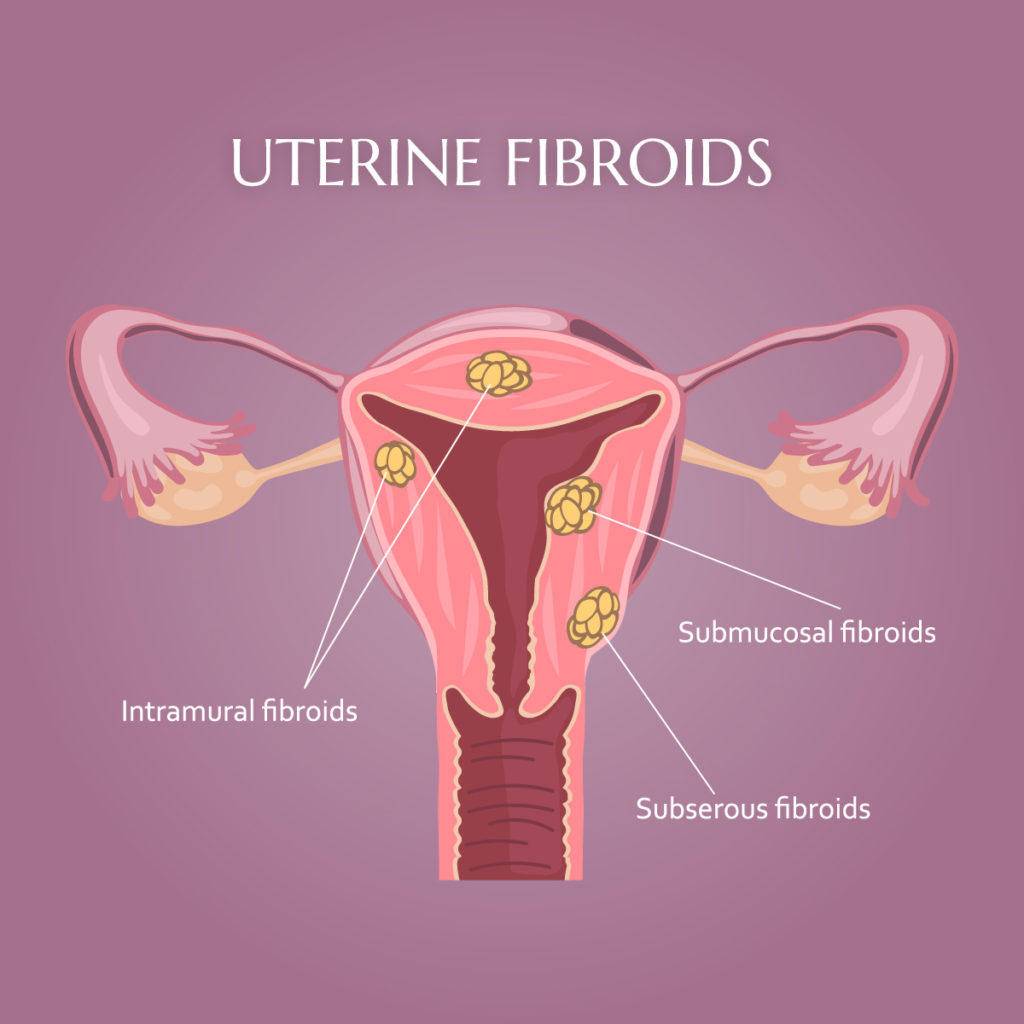Uterine fibroids are one of the most common gynecological conditions seen in America and a leading cause of uterine surgery for premenopausal women. Roughly 70%* of Caucasian women will experience uterine fibroids, and the rate is higher for African-American women who generally report stronger symptoms at younger ages. Uterine fibroids may be asymptomatic for some women and severely problematic for others. Uterine fibroid removal procedures are also the second most common surgical procedure after Caesarean section operations among premenopausal women.
What Are Uterine Fibroids?
Uterine fibroids are growths that appear in and on the uterus. These benign tumors grow in the muscle tissue of the uterine walls and rarely indicate cancer. The exact cause of uterine fibroids remains unknown, and these growths may eventually become quite large and cause intense symptoms. Other women may develop uterine fibroids and never notice any adverse symptoms. Other common names for uterine fibroids include leiomyomas, myomas, uterine myomas, and fibromas.
Types Of Uterine Fibroids
The size and location of uterine fibroids are the major contributing factors in the severity of negative symptoms. Gynecologists generally divide uterine fibroids into four categories:
- Intramural fibroids, the most commonly diagnosed type that manifest within the walls of the uterus. These fibroids may eventually grow and distort the shape of the womb.
- Subserosal fibroids, which form on the outer walls or serosa of the uterus. These fibroids can eventually cause the uterus to appear larger on one side.
- Predunculated fibroids, which are subserosal fibroids that develop long stems that support the bodies of the tumors.
- Submucosal fibroids, the least common type of fibroids found in the myometrium or middle muscle layer of the uterus.
Any of these types of uterine fibroids may cause adverse symptoms of varying degrees or no symptoms at all. Although there is no clearly defined cause of uterine fibroids, women can refer to several indicators to determine their level of risk of yet undetected uterine fibroids. However, uterine fibroids requiring treatment cause adverse symptoms that most women would report to their gynecologists as soon as symptoms appear.
Indicators Of Uterine Fibroid Risk
Although there is no firmly defined cause of uterine fibroids, medical researchers point to various possible causes and contributing factors that all women should know.
- The ovaries produce estrogen and progesterone, two vital hormones for proper reproductive cycles. These hormones regenerate the uterine lining during each menstrual cycle, potentially stimulating uterine fibroid growth.
- Genetics may also predispose a woman to developing uterine fibroids. If your mother, grandmother, or other female relatives experienced uterine fibroids in the past, you could as well.
- Pregnancy causes an increase in estrogen and progesterone production to maintain the uterine lining. This may lead to uterine fibroids growing rapidly during a pregnancy.
- Medical research points to obesity as a possible contributing factor to uterine fibroids.
- African-American women generally face a higher risk of developing uterine fibroids, and women over 30 in general face the greatest risk.
Discuss any concerns about your risk factors or medical history with your gynecologist, but remember that uterine fibroids may not require treatment or removal at all unless they cause severe adverse symptoms.
Are Uterine Fibroids Cancerous?
While there is a risk of a uterine fibroid turning cancerous, it is a very small chance. Only about one of every 1,000 uterine fibroid cases involves leiomyosarcoma, or a cancerous fibroid. ** Women should know that having uterine fibroids does not increase the risk of developing cancerous fibroids, nor do they increase the risk of developing other types of uterine cancers.
Common Symptoms
Many women have uterine fibroids and may not even know it because their conditions are asymptomatic. When they do report symptoms, the number, size, and location of their fibroids generally inform the severity of their symptoms. Some of the most commonly reported uterine fibroid symptoms include:
- Heavy menstrual bleeding
- Pelvic pain or feelings of intense pressure
- Menstrual periods lasting longer than one week
- Frequent urination
- Constipation
- Difficulty emptying the bladder
- Pain in the legs and lower back
- In rare cases, acute pain as fibroids lose blood supply and begin to die
Any woman who experiences these or other adverse symptoms should report them to her gynecologist as soon as possible.
Fibroids may not interfere with pregnancy in some cases, but in others they can cause infertility or even loss of pregnancy. Submucosal fibroids generally carry the greatest risk of interfering with pregnancy, but any type of fibroids may lead to fetal growth restriction, placental abruption, or preterm delivery.
When To See A Doctor
Women who experience sudden changes in menstrual cycles, experience excessively heavy, painful or prolonged periods, or periods lasting more than one week should seek medical care as soon as possible. Other worrisome symptoms that require immediate treatment include blood spotting between periods, pelvic pain that does not go away, and difficulty emptying the bladder. Any onset of sudden, sharp pain should also be cause to see a gynecologist as soon as possible.
Treating Uterine Fibroids
Lifestyle changes and holistic therapies may help ease the symptoms of uterine fibroids and prevent flare-ups in the future. Yoga, massage, and meditation can have positive effects, and dietary changes that include foods rich in flavonoids can boost overall nutrition and reduce the negative impact of fibroids. Other common treatments include medications, contraceptive devices, and surgery. Hormone medications can restore appropriate levels of estrogen and progesterone in the bloodstream and limit the blood flow to uterine fibroids. Anti-inflammatory painkillers and some forms of birth control may also ease symptoms.

When a uterine fibroid diagnosis requires surgery, it is usually due to a very large fibroid or a cluster of many fibroids. Although there are minimally invasive procedures to help remove fibroids, they may grow back after surgery. If fibroids reach severe levels or grow too large, the woman may require a hysterectomy. Speak with your gynecologist as soon as possible if you believe you are experiencing adverse symptoms from uterine fibroids.

Founder and Medical Director of ARIZONA GYNECOLOGY CONSULTANTS
Dr. Kelly Roy is a specialist in surgical gynecology and advanced laparoscopy (and hysteroscopy). She is a long-time resident of Arizona and obtained her Bachelor of Science degree in Biomedical Engineering at Arizona State University before finishing her Doctorate of Medicine at the University of Arizona in 1997.
Dr. Roy completed her residency in Obstetrics and Gynecology at the then “Banner Good Samaritan Hospital” (now Banner University Medical Center), in Phoenix Arizona in 2001.
Well known for her teaching and surgical ability, she is on the faculty at the residency program at both Banner University Medical Center and Saint Joseph’s Hospital in central Phoenix and is a Clinical Assistant Professor of Medicine at the University of Arizona College of Medicine, Phoenix Campus. Dr. Roy has taught advanced surgical techniques to medical students, residents, fellows and colleagues for over 15 years.
Dr. Roy is also a consultant to the medical device industry and has participated in the design and clinical testing of many instruments and surgical devices available on the world-wide market today.
Read More About Dr. Kelly Roy, MD | WebMD Profile | Health.USNews.com Profile | Current Obstetrics and Gynecology Reports: TFA with the Sonata System


